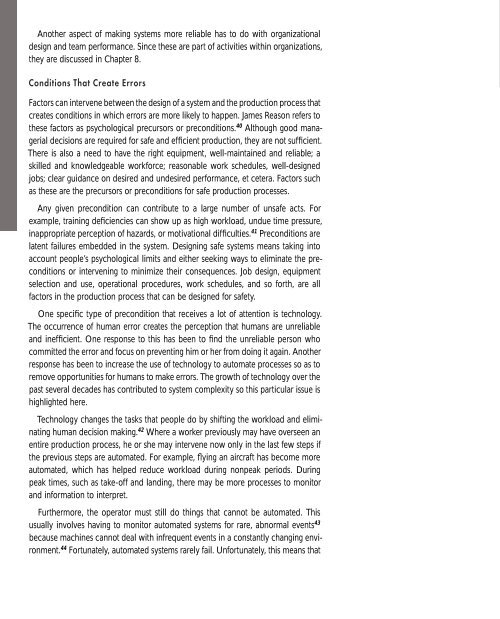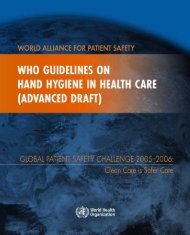Adverse event reporting.pdf
Adverse event reporting.pdf
Adverse event reporting.pdf
You also want an ePaper? Increase the reach of your titles
YUMPU automatically turns print PDFs into web optimized ePapers that Google loves.
Another aspect of making systems more reliable has to do with organizational<br />
design and team performance. Since these are part of activities within organizations,<br />
they are discussed in Chapter 8.<br />
Conditions That Create Errors<br />
Factors can intervene between the design of a system and the production process that<br />
creates conditions in which errors are more likely to happen. James Reason refers to<br />
these factors as psychological precursors or preconditions. 40 Although good managerial<br />
decisions are required for safe and efficient production, they are not sufficient.<br />
There is also a need to have the right equipment, well-maintained and reliable; a<br />
skilled and knowledgeable workforce; reasonable work schedules, well-designed<br />
jobs; clear guidance on desired and undesired performance, et cetera. Factors such<br />
as these are the precursors or preconditions for safe production processes.<br />
Any given precondition can contribute to a large number of unsafe acts. For<br />
example, training deficiencies can show up as high workload, undue time pressure,<br />
inappropriate perception of hazards, or motivational difficulties. 41 Preconditions are<br />
latent failures embedded in the system. Designing safe systems means taking into<br />
account people’s psychological limits and either seeking ways to eliminate the preconditions<br />
or intervening to minimize their consequences. Job design, equipment<br />
selection and use, operational procedures, work schedules, and so forth, are all<br />
factors in the production process that can be designed for safety.<br />
One specific type of precondition that receives a lot of attention is technology.<br />
The occurrence of human error creates the perception that humans are unreliable<br />
and inefficient. One response to this has been to find the unreliable person who<br />
committed the error and focus on pr<strong>event</strong>ing him or her from doing it again. Another<br />
response has been to increase the use of technology to automate processes so as to<br />
remove opportunities for humans to make errors. The growth of technology over the<br />
past several decades has contributed to system complexity so this particular issue is<br />
highlighted here.<br />
Technology changes the tasks that people do by shifting the workload and eliminating<br />
human decision making. 42 Where a worker previously may have overseen an<br />
entire production process, he or she may intervene now only in the last few steps if<br />
the previous steps are automated. For example, flying an aircraft has become more<br />
automated, which has helped reduce workload during nonpeak periods. During<br />
peak times, such as take-off and landing, there may be more processes to monitor<br />
and information to interpret.<br />
Furthermore, the operator must still do things that cannot be automated. This<br />
usually involves having to monitor automated systems for rare, abnormal <strong>event</strong>s 43<br />
because machines cannot deal with infrequent <strong>event</strong>s in a constantly changing environment.<br />
44 Fortunately, automated systems rarely fail. Unfortunately, this means that
















